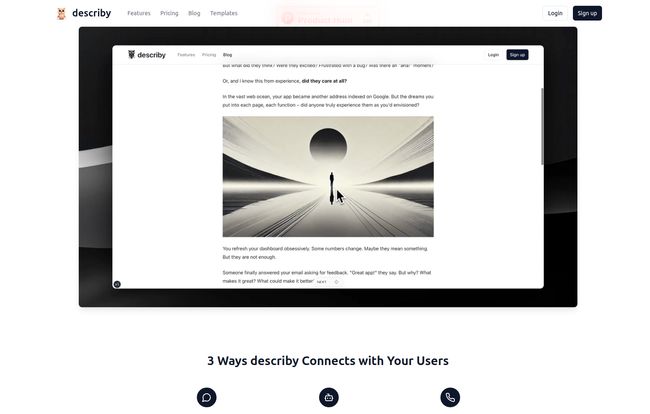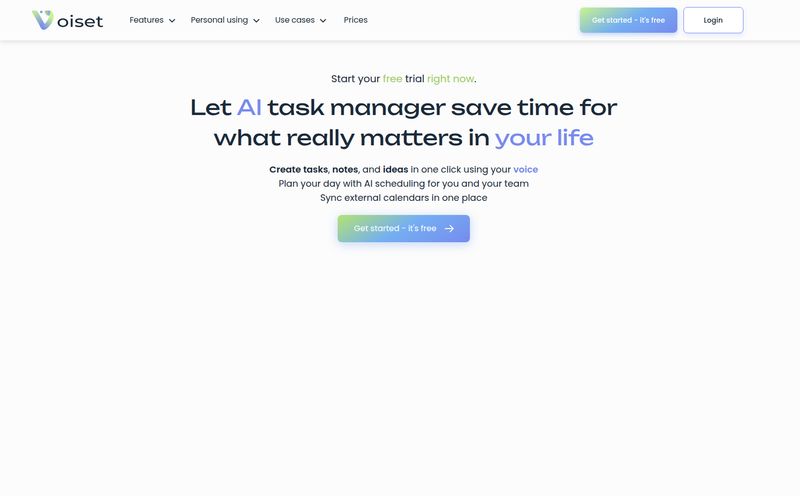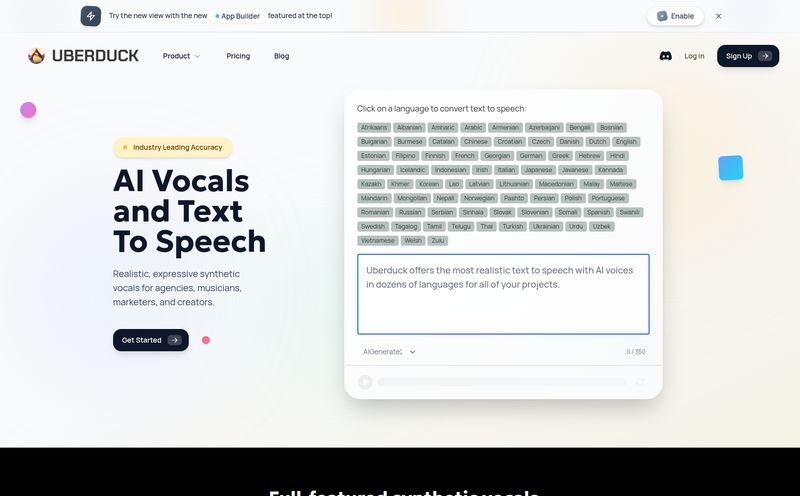We all know we need user feedback. It’s the lifeblood of any good product, the secret sauce to lowering churn, and the map that leads to the treasure of product-market fit. But actually getting that feedback? Ugh. It can feel like pulling teeth.
You either send out a sterile survey that gets a 3% response rate (and half of those are just your mom), or you spend weeks coordinating schedules for a 30-minute Zoom call where the user feels too awkward to give you their brutally honest opinion. I’ve been there. I’ve bribed people with Starbucks gift cards. I’ve sat through painful silences. There has to be a better way.
Well, I stumbled across a tool on ProductHunt called describy that claims to be that better way. It promises to automate the entire user interview process with an AI voice agent. An AI that just… calls up your users and chats with them? My inner skeptic immediately raised an eyebrow, but my inner, overworked product-obsessed marketer was intrigued. So, I dug in.
So, What Exactly is This AI Magic Called Describy?
Think of describy as a tireless, 24/7 user researcher for your team that runs on code instead of caffeine. At its core, it's a platform that uses a conversational AI to conduct voice interviews with your users to gather qualitative feedback about your web application. No scheduling, no awkward small talk, no more trying to decipher one-word answers from a form.
Instead of you having to do the interview, describy’s AI does it for you. It's designed to feel more natural than a survey, asking follow-up questions and letting users speak their minds freely. The goal is to get that rich, nuanced feedback you’d normally only get from a one-on-one call, but at scale and without you lifting a finger. A pretty bold claim, right?
The Agony of the Old Way vs. The Automation of Describy
We've all built something we thought was brilliant, only to watch users completely ignore the one feature we spent months perfecting. Why? We often don't know because asking is such a pain. The classic methods are broken:
- Surveys & Forms: They're static. You can't ask a follow-up question. They’re boring, and the data you get back is often shallow.
- Manual Interviews: They're amazing for depth, but a total time-sink. Finding users, scheduling, interviewing, transcribing... it's a full-time job.
Describy basically tries to smash these two worlds together. It aims for the scale of a survey with the depth of an interview. The AI can have hundreds of conversations simultaneously, and you just get the neatly transcribed and analyzed results. It’s a fascinating proposition for any team that's serious about user-centric design but is stretched thin on resources.

Visit describy
How Describy Actually Talks to Your Users
This isn't just a single-trick pony. The platform gives you three distinct ways to connect with your audience, which I appreciate. Flexibility is always a win in my book.
The Dedicated Interview Room (Standalone Web Page)
This is the simplest approach. Describy gives you a dedicated, standalone webpage. You can send this link to your users via email, social media, or after they've completed a certain action in your app. They click the link, land on the page, and start talking to the AI. Simple, clean, and great for targeted feedback campaigns.
The Friendly Pop-up on Your Site (Embedded Widget)
This is probably my favorite feature. The Pro plan lets you embed a describy widget directly onto your website or web app. Imagine a user just spent five minutes on your pricing page without converting. You could trigger the widget to pop up and ask, “Hey, got a second to share what you were looking for today?” It’s contextual feedback at its finest, capturing users in the moment their thoughts are freshest.
The Old-School Phone Call, But with a Robot
Okay, this one has huge potential. Describy can have its AI agent actually call your users on their mobile phones for an interview. This could be massive for getting feedback from less tech-savvy audiences or for services where a phone call feels more personal. It's a bold move, and I'm curious to see the pickup rate on these calls.
Diving into the Describy Pricing Model
Alright, let's talk turkey. How much does this AI-powered convenience cost? Describy uses a per-conversation pricing model, which has its pros and cons. It’s great for starting small, but you need to keep an eye on it if you plan to scale up. All plans seem to come with a ProductHunt deal for 3 free conversations, which is a nice touch to let you dip your toes in the water.
Here’s a quick breakdown of their pre-launch pricing:
| Plan | Price per Conversation | Key Features |
|---|---|---|
| Starter | $2 (Post-launch) | Separate interview page, transcripts, basic analytics. No minimum commitment. |
| Pro | $1.80 (Post-launch) | Everything in Starter + embeddable website plugin, advanced analytics. Minimum 20 conversations/month. |
| Enterprise | Contact for Price | Everything in Pro + user segmentation, multilingual support, advanced integrations & sentiment analysis. |
The per-conversation model always gives me a little pause. It requires you to be very intentional about who you interview. However, paying $2 for a transcribed, automated interview that I didn't have to run myself? That's honestly a steal compared to the cost of my own time or paying for user testing platforms which can be much more expensive.
My Honest Take: The Good and The Not-So-Good
No tool is perfect. After looking it all over, here’s my brutally honest take.
What I'm Excited About
The automation is the killer feature. The idea of setting up a campaign and just having feedback roll in is a dream for busy teams. The multiple connection methods (page, widget, phone) make it incredibly versatile. And getting full transcripts and analytics means you're not just getting opinions; you're getting actionable data. That's a huge win. The ProductHunt deal for free conversations makes trying it a no-brainer.
Where I'm a Bit Cautious
The pricing, while fair per unit, could get expensive if you're not careful. The minimum 20-conversation commitment on the Pro plan means you need to be sure you'll use it consistently. And let's face it, some users might just be weirded out by talking to a robot. The quality of the AI's conversational skill is everything here—if it sounds like a clunky old IVR system, the quality of feedback will plummet. I also didn't see an explicit free-forever plan, which is often a nice safety net for very small startups.
So, Who is Describy Really For?
I see this being a fantastic tool for a few specific groups:
- Early-Stage SaaS Companies: When you're pre-product-market fit and need to iterate fast, getting a constant stream of feedback is crucial.
- Product Managers & UX Teams: For teams that are constantly running tests and need to validate hypotheses without bogging down their entire sprint.
- Marketers: To understand why users are bouncing from landing pages or what messaging truly resonates with them.
If you're a large corporation with a dedicated user research department, this might be a great supplement, but if you're a smaller, agile team, this could be a genuine game-changer.
Final Thoughts: Is It Worth a Shot?
Look, the quest for authentic user feedback is never-ending. Tools like Describy represent a really interesting shift in how we approach it. Moving from static forms to dynamic, AI-driven conversations feels like the natural next step. While I have my reservations about the adoption of voice AI for this purpose and the pricing model, the potential time-savings and data depth are undeniable.
At the end of the day, the proof is in the pudding. With a deal to get your first few conversations for free, it seems like a low-risk experiment for any team that's tired of the old way of doing things. I’m optimistic. Anything that gets us closer to our users with less friction is a win in my book.
Frequently Asked Questions about Describy
- Is the AI voice on describy robotic?
- This is a major concern with any voice AI. While I haven't tested it personally, the success of the platform hinges on the AI sounding natural and conversational. Modern AI has come a long way from the choppy voices of the past, but users will ultimately be the judge. I'd recomend using one of your free trial conversations to test it on yourself first.
- Do I really get 3 free conversations on any plan?
- Yes, according to their pricing page, the ProductHunt deal for 3 free conversations is available on the Starter, Pro, and even Enterprise plans. This is their way of letting you test the service's effectiveness before committing.
- What kind of integrations does the Enterprise plan offer?
- The site mentions "Integration with multiple tools" for Enterprise clients. This typically means connecting to your existing workflow software, like CRMs (e.g., Salesforce, HubSpot), project management tools (e.g., Jira, Trello), or data warehouses for deeper analysis.
- Is the per-conversation pricing worth it?
- It depends on your ROI. If a $2 conversation gives you an insight that helps you retain a customer paying you $50/month, it's absolutely worth it. It's more expensive than a survey but far cheaper and faster than manual interviews or many formal user testing platforms. It's a value proposition you have to calculate for your own business.
- How is my user data handled?
- Any company handling user conversations needs to be serious about data privacy. While not explicitly detailed on the landing page, you should assume they have a privacy policy in place. For specifics on data storage, encryption, and compliance (like GDPR or CCPA), you would need to consult their official documentation or contact their support team.
- Can I use it for more than just web apps?
- While the focus is on web apps, the core concept could apply to almost any product or service. You could use the standalone page or phone call features to get feedback on a physical product, a service experience, a course, or even an idea you haven't built yet.



